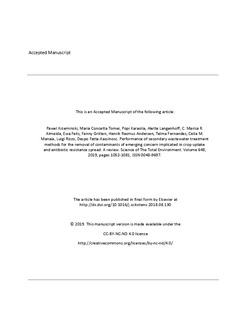| dc.description.abstract | Contaminants of emerging concern (CEC) discharged in effluents of wastewater treatment plants (WWTPs), not specifically designed for their removal, pose serious hazards to human health and ecosystems. Their impact is of particular relevance to wastewater disposal and re-use in agricultural settings due to CEC uptake and accumulation in food crops and consequent diffusion into the food-chain. This is the reason why the chemical CEC discussed in this review have been selected considering, besides recalcitrance, frequency of detection and entity of potential hazards, their relevance for crop uptake. Antibiotic-resistant bacteria (ARB) and antibiotic resistance genes (ARGs) have been included as microbial CEC because of the potential of secondary wastewater treatment to offer conditions favourable to the survival and proliferation of ARB, and dissemination of ARGs. Given the adverse effects of chemical and microbial CEC, their removal is being considered as an additional design criterion, which highlights the necessity of upgrading conventional WWTPs with more effective technologies. In this review, the performance of currently applied biological treatment methods for secondary treatment is analysed. To this end, technological solutions including conventional activated sludge (CAS), membrane bioreactors (MBRs), moving bed biofilm reactors (MBBRs), and nature-based solutions such as constructed wetlands (CWs) are compared for the achievable removal efficiencies of the selected CEC and their potential of acting as reservoirs of ARB&ARGs. With the aim of giving a picture of real systems, this review focuses on data from full-scale and pilot-scale plants treating real urban wastewater. To achieve an integrated assessment, technologies are compared considering also other relevant evaluation parameters such as investment and management costs, complexity of layout and management, present scale of application and need of a post-treatment. Comparison results allow the definition of design and operation strategies for the implementation of CEC removal in WWTPs, when agricultural reuse of effluents is planned. | nb_NO |

